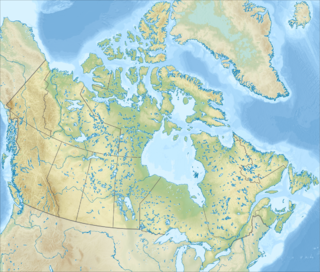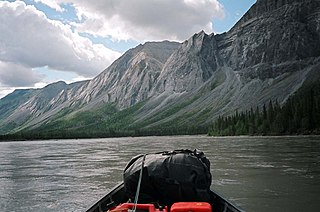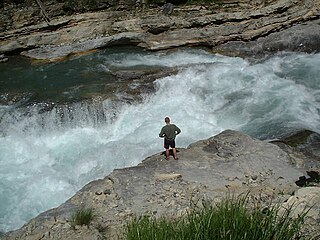
Nahanni National Park Reserve in the Dehcho Region of the Northwest Territories, Canada, approximately 500 km (311 mi) west of Yellowknife, protects a portion of the Mackenzie Mountains Natural Region. The centrepiece of the park is the South Nahanni River. Four noteworthy canyons reaching 1,000 m (3,300 ft) in depth, called First, Second, Third and Fourth Canyon, line this spectacular whitewater river. The name Nahanni comes from the indigenous Dene language name for the area; Nahʔa Dehé, which means "river of the land of the Nahʔa people", who some now speculate may have been the ancestors of the modern day Navajo people.

Kings County is located in eastern Prince Edward Island, Canada.

The Liard River flows through Yukon, British Columbia and the Northwest Territories, Canada. Rising in the Saint Cyr Range of the Pelly Mountains in southeastern Yukon, it flows 1,115 kilometres (693 mi) southeast through British Columbia, marking the northern end of the Rocky Mountains and then curving northeast back into Yukon and Northwest Territories, draining into the Mackenzie River at Fort Simpson, Northwest Territories. The river drains approximately 277,100 square kilometres (107,000 sq mi) of boreal forest and muskeg.

The Mackenzie Mountains are a mountain range forming part of the Yukon-Northwest Territories boundary between the Liard and Peel rivers. The range is named in honour of Canada's second prime minister, Alexander Mackenzie, as well as the explorer. Nahanni National Park Reserve and Nááts'ihch'oh National Park Reserve are in the Mackenzie Mountains.

Nahanni Butte Water Aerodrome(TC LID: CET8), was adjacent to the community on the South Nahanni River and was open from the middle of June until October. It was located near Nahanni Butte, Northwest Territories, Canada, east of the Nahanni National Park Reserve, on an arm of the South Nahanni River.

Nahanni Butte is a "Designated Authority" in the Dehcho Region of the Northwest Territories, Canada. The community is located at the confluence of the Liard and South Nahanni Rivers in the southwestern part of the NWT.
Gitnadoiks River Provincial Park is a 58,000 hectare provincial park in British Columbia, Canada. It is centred on the Gitnadoix River, a tributary of the Skeena River in Northwestern British Columbia, 50 km west of Terrace.
Within the traditional territory of the Tsimshian people, the park is in a remote, wilderness setting in the Kitimat Ranges of the Coast Mountains and is inaccessible by road.
Fort Smith Region was a former Statistics Canada census division, one of two in the Northwest Territories, Canada. It was abolished in the 2011 census, along with the other census division of Inuvik Region, and the land area of the Northwest Territories was divided into new census divisions named Region 1, Region 2, Region 3, Region 4, Region 5, Region 6.
The Burnside River is a river in the Canadian territory of Nunavut. It has its headwaters at Contwoyto Lake, flows across the Precambrian Shield's Contwoyto Plateau, flows through isolated and rugged tundra, into Lake Kathawachaga, and through the Wilberforce Hills region. Before emptying into Bathurst Inlet on the Arctic Ocean, the Mara River (Nunavut) empties into the Burnside River. The river has an island, Nadlak, historically notable for Inuit use of caribou antlers as hut roof infrastructures.

The Dehcho Region or Deh Cho is one of five administrative regions in the Northwest Territories of Canada. According to Municipal and Community Affairs the region consists of six communities with the regional office situated in Fort Simpson. All communities in the Dehcho are predominantly Dehcho First Nations.

Nááts'ihch'oh National Park Reserve is a Canadian national park reserve encompassing parts of the South Nahanni River watershed in the Northwest Territories. The name means "stands like a porcupine" in the Dene language. The national park reserve covers an area of 4,850 square kilometres (1,873 sq mi), protecting the Sahtú Settlement Area of the upper South Nahanni River watershed, adjoining Nahanni National Park Reserve. The two areas are to be managed separately, similar to Banff and Jasper National Parks which are also side by side. The South Nahanni watershed is home to several endangered species, including grizzly bears and boreal woodland caribou. The area is also known for its moose, Dall sheep and the northernmost population of mountain goats in Canada.

The 1985 Nahanni earthquakes is the name for a continuous sequence of earthquakes that began in 1985 in the Nahanni region of the Northwest Territories, Canada. The largest of these earthquakes occurred on December 23, reaching 6.9 on the moment magnitude scale. This is one of the most significant earthquakes in Canada during the 20th century. The earthquakes had a long succession of aftershocks and jolts. The earthquakes amazed both the general public and the earth science community and have been felt in the Yukon, Alberta, Saskatchewan, British Columbia, and southeastern Alaska.
The Tahltan First Nation, also known as the Tahltan Indian Band, is a band government of the Tahltan people. Their main community and reserves are located at Telegraph Creek, British Columbia. Their language is the Tahltan language, which is an Athabaskan language also known as Nahanni, is closely related to Kaska and Dunneza. Their Indian and Northern Affairs Canada band number is 682. The Tahltan First Nation is joined with the Iskut First Nation in a combined tribal council-type organization known as the Tahltan Nation.

North Nahanni River is a river in the Northwest Territories of Canada. It is a major tributary of the Mackenzie River.
The Nahanni Formation is a stratigraphical unit of Givetian age in the Western Canadian Sedimentary Basin.
Nahanni is a 1962 short documentary from the National Film Board of Canada directed by Donald Wilder, following Albert Faille, an elderly explorer and prospector, down the Nahanni River, in search of a legendary gold mine. The film is scripted by William Weintraub with a musical score by Eldon Rathburn. Awards for the film included two prizes at the 1963 Canadian Film Awards as well as the award for Best Color Film Produced in 1962 at the Canadian Cinematography Awards.
Region 4 is the name of a Statistics Canada census division, one of six in the Northwest Territories, Canada. It was introduced in the 2011 census, along with Regions 1, 2, 3, 5, and 6, resulting in the abolition of the former census divisions of Fort Smith Region and Inuvik Region.











